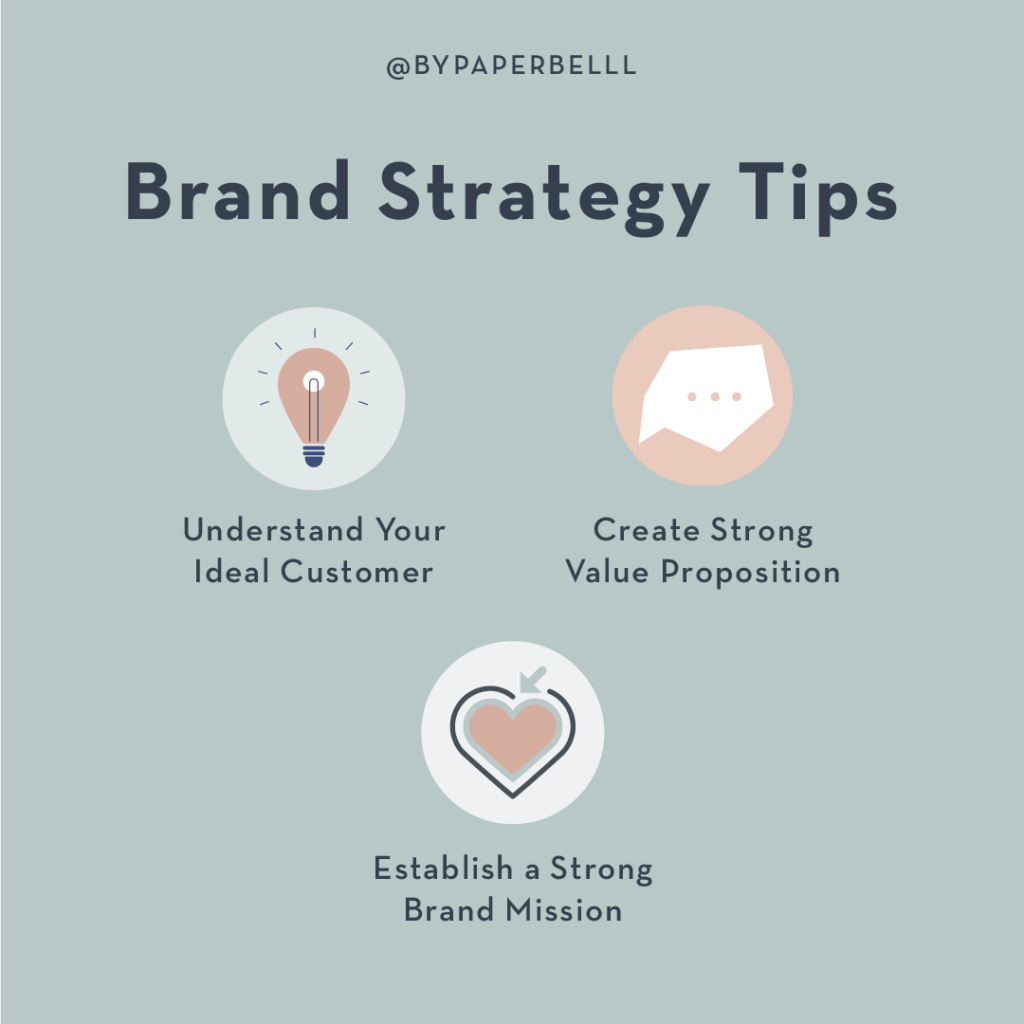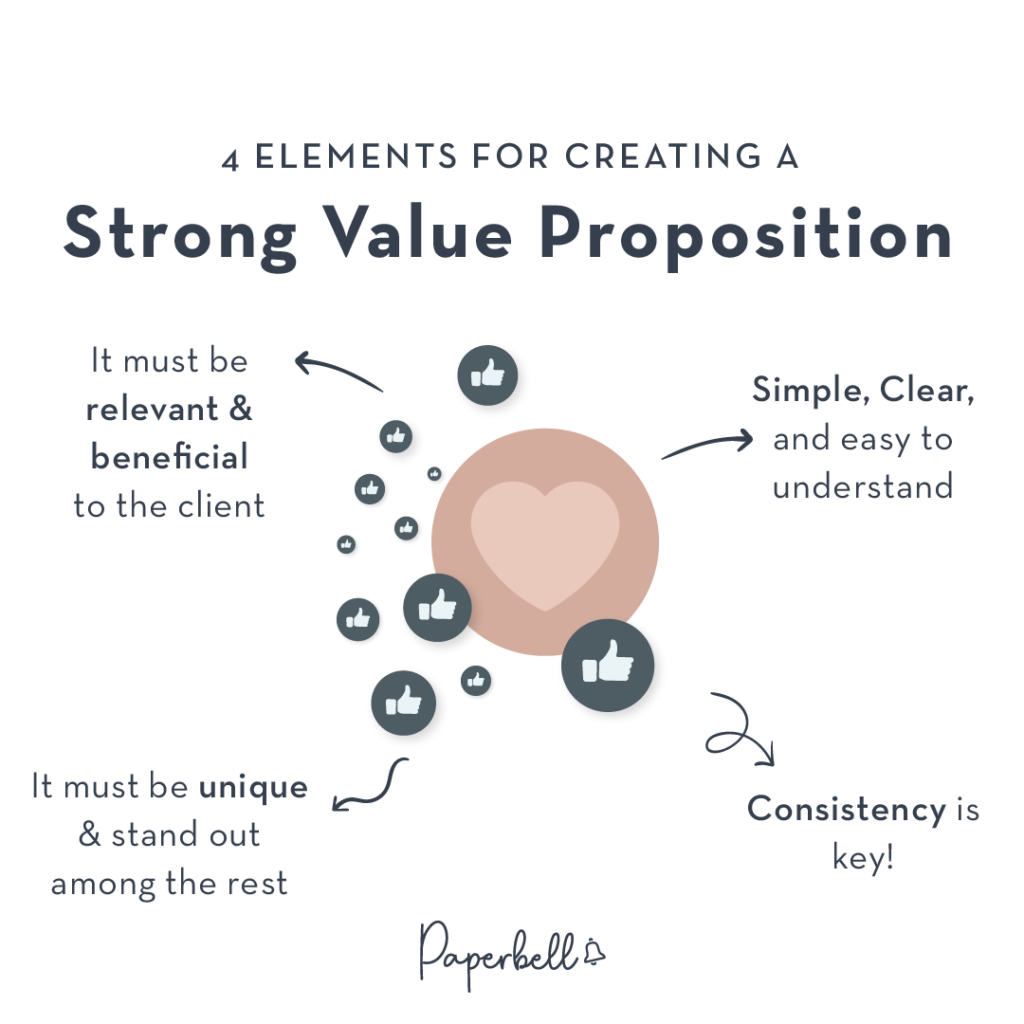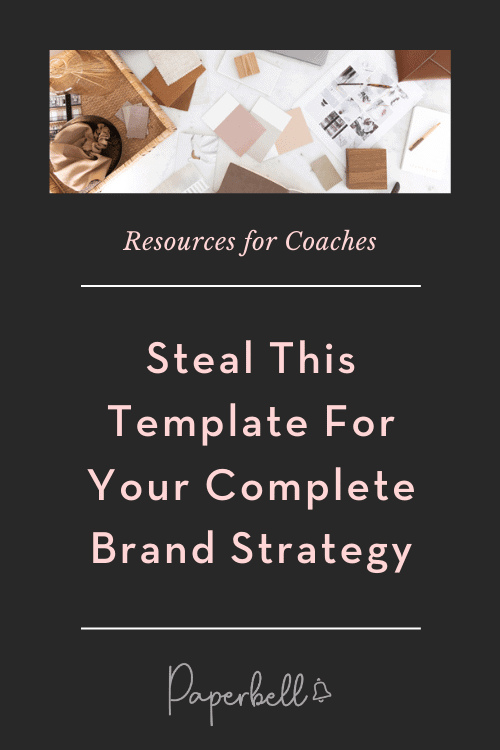Building a brand can seem daunting at first.
Where do you start?
The first place most people think about is hiring a designer to create a website and logo design.
But, if you want to create a lasting brand, your website and logo are the last steps in the brand strategy process.
Instead, to build a strong brand, you’ll need to start with your overall brand strategy. Use the free brand strategy template provided in this post to get your brand vision on paper!
What is a Brand Strategy?
A brand strategy is a comprehensive, long-term plan that outlines how a brand will establish its identity, communicate its value, and differentiate itself in the market.
Your brand strategy shapes your brand identity. It’s all about how you want your business to be perceived by customers.
An effective brand strategy document includes details on your:
- Brand personality
- Brand purpose
- Brand voice
- Brand story
- Mission
- Vision
- Values
- Target audience
- Brand positioning
- Visual identity
Taking the time to create your brand strategy in the beginning will make your job easier as you grow. A well-thought-through brand strategy document will help you determine the following:
- What copy to write
- What visuals to use
- Where to focus your marketing efforts
- Make decisions about what’s “on-brand” or “off-brand”
With a great brand strategy, you can build a coaching business that’s fully aligned with you and connects you with your audience.
What is a Branding Strategy vs. Branding Tactics?
A branding strategy is a long-term plan that defines how you want to build, position, and communicate your brand to achieve specific goals. It focuses on your brand’s overall vision, messaging, and identity.
Branding tactics are the specific actions, tools, and campaigns you use to implement your strategy and engage with your target audience in the short term.
Why is a Brand Strategy Important?
Working on your own brand strategy allows you to build recognition so people immediately know who you are and what you stand for.
If you create content and use marketing strategies randomly, without consistency, your potential customers will be confused.
If you have mismatched values, people won’t understand what you stand for and will hesitate to invest in you. This can be detrimental to your sales and growth trajectory.
A brand strategy is not only about the visual elements of your brand but also the words you use, how you communicate with people, and how you make them feel with your presence. A brand strategy helps you build your brand’s voice and promise to clients.
Creating a great brand strategy will affect your ability to stand out in the market and attract customers. People will positively associate with you, making them more likely to engage with you.
Effective branding will also enable consistency across your business; it gives a point of reference to your team, informs your marketing strategy, and guides your decisions. In addition to this, you can work with a HubSpot agency that can take your marketing needs to the next level.
If, in the future, you decide to launch new products, your brand strategy can inform those too.
3 Tips for Writing an Effective Brand Strategy
You may be clear on the why behind your brand, but how will you communicate it to your target clients?
Here are the three key elements to creating a brand strategy:

1. Understand Your Ideal Customer
Many brands build a product based on a hunch about what they think their customer wants. Don’t make that mistake! For your brand to be successful, the most important step is to understand your target audience—what they want, what they think they need, and what they really need.
The best way to do this is through research. Conduct surveys or interviews with your target clients to understand their needs.
You can try the “Jobs to Be Done” framework to understand what drives your customers’ behavior. Understanding their pain points will help you create messaging that resonates.
Listen to the problem they are trying to solve and what they’ve tried in the past to solve it. This will give you insight into how to position your brand in the market and communicate what it offers.
Listen carefully to why they’ve “fired” previous solutions. How could your brand speak to their needs better? How can you show you provide the emotional benefits they are looking for? Why is your offer the best one for them out there?
When interviewing your customers, make sure you ask open-ended questions. These questions don’t direct the person to the answer you want and can’t be answered with a simple yes or no.
Some questions you can ask in your interviews are:
- What problems have you been facing in [insert area/industry you are in]?
- What solutions have you tried to solve the problem?
- Why didn’t those solutions work?
- What made you consider working with me/buying my product or service?
Remember that it’s more important to be curious about their answers and ask follow-up questions than to follow a set of questions you prepared beforehand.
2. Create a Strong Value Proposition
A value proposition or unique selling proposition (USP) is the value you provide to your customers that makes them want to choose you over your competitors or any other existing brand.
It is not a tagline or slogan, although it can be used to create one.
To create a strong value proposition, it must have these four elements:
- Relevant and beneficial: It must be something that solves their problems or improves their situation.
- Unique: It must be something unique and differentiates your brand from your competitors.
- Consistently deliverable: It must be something that you can consistently deliver throughout your client’s experience with your brand.
- Simple and clear: It must be clear and easy for your clients to understand. Don’t use jargon or lengthy sentences to explain what your value is.
Start by listing all the benefits your brand provides your target audience. You can use the insights you gained from customer interviews to help you create this list.
Then, figure out what makes your brand unique compared to your competition. For this, my team and I usually conduct a comprehensive competitor analysis. You’ll want to understand what others are doing and what problems they are solving and not solving.

Here are a couple of value proposition examples from top brands:
Evernote: Accomplish more with better notes. Evernote helps you capture ideas and find them fast.
This statement is relevant and beneficial to Evernote’s audience. It’s unique, simple, and clear.
The brand consistently delivers on this promise by improving its platform to simplify how people organize their notes.
Airbnb: Belong everywhere. Experience travel in an entirely new way.
This is relevant and beneficial to Airbnb’s audience: travelers who want to experience and immerse themselves in the local culture.
It tells people they can stay in a place that feels like home anywhere and book adventures unique to the city they visit.
Airbnb delivers on this brand statement through its platform, where customers can search for homes and experiences worldwide. Their brand is an excellent example of delivering messages consistently to customers.
3. Define Your Brand’s Key Components
The four key components of your brand are your purpose, values, mission, and vision. Let’s look at how you can define these.
Define Your Brand’s Purpose
Your brand’s purpose is the passion behind why you created the brand in the first place. It’s what drives it to succeed.
For example, Tom’s original brand purpose was to provide shoes to children in developing countries who didn’t have shoes.
This was the driving force behind why the brand existed and created its one-for-one model, where every pair of shoes purchased provided a pair of shoes for a child in need.
Ask yourself: Why did you start your brand?
Identify Your Brand’s Values
Your core brand values are more than words on a piece of paper; they are part of the heart and soul of your brand. They are your brand’s personality traits.
Your brand values must reflect your core beliefs and what you stand for. It must be something you can consistently deliver to clients.
They are not only buying your products and services from your brand because they like what you sell, but because they have shared values with you. Buying from your brand is a reflection of their values as well.
The best brand values are unique since no two brands are exactly the same. Try to stay away from generic values that have no meaning.
For example, Lush Cosmetics has six unique brand values:
- Freshest Ingredients
- 100% Vegetarian
- Ethically Buying
- Handmade
- Naked
- Fighting Animal Testing
The people who buy from Lush Cosmetics care about these values and want to buy products that are sustainable, environmentally friendly, and ethical.
They are looking for better quality products they can be proud of using. They know what Lush Cosmetics stands for, which makes them more likely to be loyal as very few cosmetics brands have the same values.
Ask yourself: What do you believe in and stand for?
Create Your Brand’s Mission
Your brand mission is focused on the present moment; why your company exists today and how you want to impact your clients’ lives. It outlines actionable and tangible goals you want to accomplish.
For example, Tesla’s mission statement is “To accelerate the world’s transition to sustainable energy.” The company’s goal is to increase sustainable energy use in people’s everyday lives.
Ask yourself: What is your brand promise, and how do you want to impact your customers’ lives?
Develop Your Brand’s Vision
Unlike the mission statement, the vision statement is the future-oriented part of your brand strategy. It is meant to inspire the company to grow. For businesses looking to elevate their branding, focusing on product branding is essential. By aligning your product’s identity with your overall brand strategy, you can create a cohesive and compelling experience that resonates with your target audience.
The brand vision also articulates where the brand wants to be once it achieves its mission. You want this to be bold and forward-thinking, defining where your brand and business will evolve.
For example, Warby Parker’s vision statement is “To give everyone the right to see.” This is a powerful vision statement because it expands beyond the customers who buy their eyewear to partners who help provide vision services to underserved communities.
Ask yourself: How do you see the world changing as a result of your brand?
Document Your Brand Strategy
The above research and definitions will help keep your messaging and communications aligned with your brand. They will allow you to create materials such as:
- Brand messaging statements
- Brand voice templates
- Brand assets to share with partners
- Brand guidelines for employees (including guidelines on how to communicate with customers)
- A brand style guide (includes things like color palette, fonts, image use)
- A brand positioning statement (where you see yourself in the market)
These documents will help inform your marketing strategies and future marketing campaigns. If you decide to hire a freelance marketer, brand strategist, creative agency, or marketing expert in the future, you can share your brand guidelines with them, so they know exactly how to communicate your narrative.
The 10-Step Copy-and-Paste Brand Strategy Template
Here’s a template you can copy and paste and fill in to develop ideas for your brand strategy:
1. Who is your customer?
Record notes from your customer interviews.
2. Value proposition
Think about your brand positioning statements, unique value, and what makes you stand out.
3. Brand mission, vision, values, and purpose
- What is your core purpose?
- Identify your core values.
- What is your brand mission?
- What is your long-term vision?
4. Brand personality
How do you want your brand to be perceived?
List 3-5 adjectives that describe your brand’s tone and style (e.g., professional, approachable, empowering).
5. Customer pain points and needs
What are the main challenges of your target customers?
Identify the specific problems your coaching will solve for them.
6. Unique selling points (USPs)
What sets you apart from other coaches?
List the key reasons clients should choose you over others.
7. Key messaging
What are the core messages you want to communicate to your audience?
Encapsulate your brand’s main message in one tagline.
8. Competitor analysis
Who are your top competitors?
Write down their strengths and weaknesses and how you can differentiate yourself.
9. Brand experience
How should clients feel when working with you?
Outline the type of experience you want to create for them (e.g., personalized, transformative).
10. Visual identity
What will your brand look like? Brainstorm your brand’s color palette, fonts, and logo ideas.
Consider the visual elements that will communicate your brand’s personality and values consistently across all platforms. Additionally, explore print-on-demand items for custom-branded merchandise like t-shirts, notebooks, or mugs that can showcase your visual identity, helping to extend your brand’s presence both online and offline. Using a logo generator can also be a helpful tool to create a professional and cohesive logo that aligns with your brand’s personality and values.
Start Creating
Use this template to guide you as you build your brand. It will help you maintain consistency across platforms, creating more trust and loyalty with your clients.
Your brand strategy isn’t a complete-and-forget tool; it’s a work in progress. As your brand evolves, so will your visual identity and voice. Make sure to keep your brand guidelines updated as your brand changes over time.

Editor’s Note: This post was originally published in February 2023 and has since been updated for accuracy.








